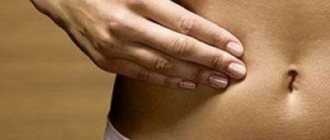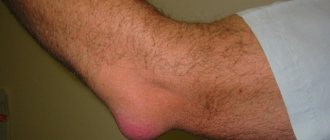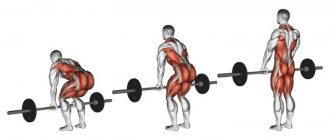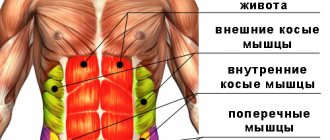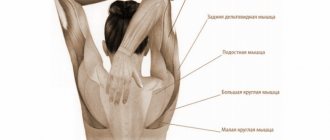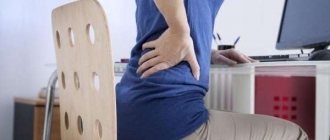Physical exercise brings enormous benefits to the body, so many are often perplexed: “Why can my lower back hurt after deadlifting?” The problem is that athletes, when severe pain occurs, do not consult a doctor, but simply take painkillers.
Pain never just happens; there is always a reason, especially if it concerns the spine.
First, let's talk about the reasons that cause severe lower back pain.
Deadlifting uses a variety of muscle groups
Causes
It is impossible to definitively answer why exactly the lower back hurts. Maybe this is due to a violation of the technique itself, or maybe it is due to overload of the spinal muscles. And sometimes the appearance of unpleasant sensations is a signal of serious violations.
If a beginner has pain after deadlifting, this is quite natural, especially if he previously led a sedentary lifestyle. But it’s a completely different matter if the pain is sharp and acute.
During such squats, the back should be in a natural position, but if it deviates, the spine experiences severe stress.
You can learn the correct technique for squatting with weights only under the supervision of a professional trainer.
You can simply hang on the horizontal bar, or use a warming ointment. All this is only a temporary relief of symptoms, which does not eliminate the causes. It is important to identify the factors that triggered the pain and undergo an examination.
In some cases, the pain factor may be the intensity of the movements performed. Sudden jerks are more likely to cause a lot of trouble than to increase the effectiveness of your training.
A low or high bar is a direct road to back problems. Also, if you pull in your stomach too much during squats, your lower back will round. Taking a deep breath and using an athletic belt will help avoid incorrect execution.
Another reason may be the desire to experiment. Such attempts can be fraught with violation of the integrity of the intervertebral discs. In addition, discomfort may indicate the development of osteochondrosis and complications associated with it.
Also, excessive load can cause protrusion, during which the intervertebral disc moves beyond the spinal column, while the fibrous ring maintains its integrity. Protrusion causes pinching of nerves and blood vessels. A serious complication of the disease, if left untreated, is intervertebral hernia.
Straight grip
When deadlifting, you should avoid different positions of your palms on the bar.
With light weights, the grip does not affect anything. But as they increase, different grips can lead to asymmetrical stress on the back muscles. This will cause them to develop unevenly and cause pain.
It is best to start training
with an empty bar
. Perform a couple of approaches, make sure the technique is correct, and only then lift the weights. This helps to consolidate the technique at the neural level: stable connections will appear in the brain, which will then help you do the deadlift correctly “automatically.”
How to distinguish between “correct” and “pathological” pain?
Common muscle pain that appears after training is characterized as follows:
- appears as a result of the accumulation of lactic acid;
- appears the next day after training;
- dull pain;
- localization of pain exclusively in the place of the spine where the load was applied;
- the pain intensifies when walking, but goes away with rest;
- Over time, the painful sensations gradually subside, and after a few days they completely disappear.
If your lower back hurts, this is not a reason to stay in bed
Pathological pain can be described as follows:
- appears as a result of muscle trauma;
- pain appears immediately;
- acute nature of the pain;
- pain may radiate to other parts of the back;
- unpleasant sensations do not go away even at rest;
- The discomfort even intensifies over time and does not go away for a long time.
We recommend reading:
Why does my lower back hurt after training?
Be objective
If you feel that the exercise is too hard, you can’t cope, don’t torture yourself.
Apparently, your muscles are not yet ready for such a load. Start with training with your own weight: hangs on the horizontal bar, hyperextension, raises of the body and arms. Gradually you can add dumbbells, do bent-over rows, for example. Swimming works your back very well. Yoga, stretching and Nordic walking will also be good for your muscles. When they become stronger, you can move on to serious weights without the risk of injury and unnecessary pain. Spinal injuries are very dangerous
, you should not overstrain your back, especially if you are not confident in your abilities. Train regularly, alternate between different types of exercise, and give your muscles a rest. And don’t forget that any exercise must be done either correctly or not at all.
What's your favorite exercise in the gym?
Prevention
Following simple rules will help avoid pain:
- correct execution technique. It must be carefully studied and practiced. Each approach should be carried out with the correct arch in the lower back. During the beginning of the movement, when the bar lifts off, it is especially important to monitor the correct execution;
- warm-up before starting classes;
- working on strengthening your back;
- correct weight. A barbell that is too heavy will do more harm than good;
- "No!" overload of the lower back;
- "Yes"! pull-ups. This is a good opportunity to stretch not only the muscles themselves, but also the spine.
Moderate physical exercise under the supervision of a specialist will help relieve the unpleasant symptom.
What to do if your lower back hurts after deadlifting. Typical beginner mistakes
The deadlift is a weightlifting exercise that allows you to work large muscle groups. The safety and effectiveness of execution depends on the correct technique. Errors and inaccuracies can cause pain and injury.
Why is exercise dangerous?
Deadlifts are quite dangerous exercises. The load is not only on the muscles and tendons, but also on the lower back.
The weight of the projectile puts pressure on the spinal column.
If the technique is violated, there is a risk of injury to the intervertebral discs and the formation of a hernia. If the vertebrae are overly active, nerves may become pinched and severe pain may develop.
The spinal cord is located in the spine. An injury sustained while performing a deadlift can be permanent.
Causes of injuries and technical errors
The main cause of injury is violation of equipment and safety rules. Many novice athletes strive to quickly get results, so they perform deadlifts incorrectly and inattentively.
Main mistakes:
- Sudden movements. The projectile must not be thrown or lifted jerkily.
- Incorrect position of the lower back. Often inexperienced athletes round their lower back. This situation occurs with a weak back and heavy weight. To prevent this from happening, you need to select the right weight and keep your head elevated.
- Strong arch in the back and incorrect shoulder position. The back should always remain straight and the shoulder blades should be slightly pulled back. Deflection is dangerous due to injury to joints.
- Incorrect grip. Professionals recommend using a classic grip or using straps. A different grip can cause back pain.
- Violation of the training scheme. It is important to follow the principle of gradually increasing the load. A training belt should be used for insurance. With it there is less risk of breaking your back.
- Lifting up using your back. This error occurs when an athlete chooses the wrong weight. Deadlifts are not performed using the legs.
Before you start working with heavy weights, you need to work out the deep back muscles well. A well-formed corset will prevent displacement of the vertebrae. Before starting a workout, you need to warm up your muscles well and prepare them for work.
What to do if your back hurts
If your back starts to hurt when doing deadlifts, the first thing you need to do is determine the cause. If there is a sharp and spreading pain that does not go away for a long time, you need to consult a specialist and undergo appropriate diagnostics.
A dull pain when bending over may indicate overexertion of untrained muscles.
In this case, it is recommended to use warming ointments and stop training for 3-4 days. Before using an external product, you should consult a specialist and make sure there is no allergic reaction.
Should you do deadlifts when you have pain?
The causes of lower back pain can be different. With micro-tears of muscle fibers or minimal displacement of the vertebra, the exercise can be performed. Sometimes, in order to get rid of a muscle spasm, you need to load it and neighboring muscles.
The purpose of training for lower back pain is recovery, and not a full-fledged training session. To minimize the risk of dangerous injury, it is recommended to exercise under the supervision of a trainer who will correct the technique.
Prevention
The main way to prevent injuries when performing deadlifts is proper technique. You must try to keep control of your back. An important condition is the correct weight.
Basic recommendations for injury prevention:
- A workout should always begin with a warm-up. The muscles must be warm. It is first recommended to perform hyperextension without using a weighting agent.
- An athletic belt is used to relieve stress on the lower back muscles. To prevent your hands from slipping on the bar, you need to apply a little chalk to your palms.
- You need to perform deadlifts with weights of 20 kg or more. Due to the diameter of the pancake, the bar will be located at the required level.
- During the deadlift, your heels should remain on the floor to ensure good stability. Feet should be hip-width apart, toes turned inward. It is important to choose the most comfortable position for your legs so that the load from the barbell is distributed evenly across all back muscles.
- The center of weight distribution is the heels. The body must not deviate.
To avoid injury, the bar must be lowered strictly along the lifting path. In this case, movements should be smooth and accurate.
You should plan your workout correctly.
When performing deadlifts, all other similar exercises should be excluded from the lesson plan. After the deadlift, you need to do pull-ups. They will help tighten your back muscles after a heavy load.
It is important to constantly work on strengthening your back. It is advisable to select a variety of exercises.
If you experience discomfort after training, you should visit a massage therapist or go to the sauna. To prevent back pain, swimming, Nordic walking and yoga are recommended.
The deadlift is a basic strength exercise. It promotes comprehensive muscle growth. Beginner athletes often experience back pain after performing this exercise. The main reason is incorrect technique and heavy weight. To avoid injury, it is recommended to work with a trainer.
Source: https://mix-body.com/zdorove/bolit-poyasnitsa-posle-stanovoj-tyagi.html
Emergency help
If your lower back hurts terribly during training, follow these rules:
- stop the load;
- Lie in a position that minimizes pain. Lie down until the pain goes away. If this does not help, classes should be cancelled;
- You can apply ice or a cold compress to the sore spot and wait for an ambulance. Thermal procedures are not permissible, as they will only aggravate the situation, increasing swelling and inflammation.
Do not self-medicate by prescribing medications to yourself, especially those administered parenterally.
In any matter, a competent approach to business is important. When playing sports, listen to the recommendations of professionals, and if you experience alarming pain, consult a doctor.
Spinal stretching exercises at home
Not all diseases require the patient to be inpatient or sanatorium treatment. During prevention or in the initial phases of the disease, spinal and back traction complexes can be performed at home, with the prior approval of a doctor and after studying the technique. When performing spinal traction at home, preliminary preparation is necessary to warm up and relax the back muscles.
To warm up the muscles, the following procedures are carried out:
- taking a bath with warm water lasting a quarter of an hour;
- back massage with a roller or hands;
- rubbing with a hard towel.
Back stretching technique at home:
- Passive traction on a couch with an elevated headboard. An alternative to horizontal traction in a hospital. It is possible to use special orthopedic mats.
- Hanging and half-hanging traction on the horizontal bar. Analogous to vertical traction. While hanging, as you exhale, it is recommended to pull your knees towards your stomach to relax the muscles and avoid injury to the spine. Do not jump off the horizontal bar; after stretching, gently lower yourself to the floor.
- Traction using a wall and a flat surface (analogue of Evminov’s prophylactic). Having fixed a flat surface against the wall at a certain angle, you can perform the following complex:
- lying on your back with your head to the wall, support your weight with your arms and legs and do a “bicycle”;
- while on your stomach, lean on your arms and raise your legs straight;
- lying on your back, bend your knees and pull them towards your chest.
Initially, the exercises are performed as much as possible, then increased to 15–20 repetitions.
To better stretch the spine and avoid injury, it is recommended to wear a corset after each traction exercise for three hours or more. During the treatment period for the spine (usually 10–12 days), stress and physical exercise should be avoided.
What to do if you have pain
Does your lower back hurt after doing deadlifts? The phenomenon is unpleasant, but, unfortunately, not the rarest. Quite often, athletes, especially at the initial stage, encounter this problem. Why does the lower back hurt after doing the exercise and most importantly - how to avoid it? Read about it below.
The deadlift is a basic exercise that works several muscle groups at once. It is very important to master the correct technique in order to avoid mistakes that can cause pain and lead to a back injury! Below is a list of the main causes of back problems after lifting a barbell:
- Incorrect position of the lower back. Quite often, due to inexperience, athletes try to round the lower back - the lower back - when working with a barbell. This is the “sin” of athletes with insufficiently pumped weak backs who want to work with heavy weights without preparation. Never do this! If you cannot work correctly with the selected weights, simply reduce the weight. To better control your back position, raise your head and try to look forward.
- Sudden movements. Both beginners and experienced athletes allow themselves to make sharp jerks on the apparatus from time to time, thereby helping themselves to work with larger weights. Try not to do this if you don’t want to have back problems and endure terrible pain!
- Deflection in the waist and incorrect shoulder position. Try to perform deadlifts with a flat back, slightly bent legs (fully straight legs are dangerous) and pulled back shoulder blades. Do not arch your lower back, as this can lead to back pain and joint and muscle injuries!
- Incorrect grip. During the exercise, it is best to use a classic grip or straps. A different grip can be one of the reasons for improper functioning of the back muscles, causing pain and leading to injury!
If characteristic pain sensations appear in your back during or after deadlifting, you need to figure out what was their root cause.
, which spreads along the back, indicates that there could be
. If the pain does not go away, you need to stop exercising and
A dull pain that appears after exercise and intensifies when bending over indicates muscle overstrain. With this symptom, you should not exercise; it is better to keep your back at rest for several days, using warming ointments with an analgesic effect. If the pain does not go away, you should also contact a traumatologist or physiotherapist to prescribe a course of treatment.
Try to determine whether the pain is muscle or pathological:
- In the first case, there is no need to panic, but in the second case it is very important to contact a qualified specialist.
- In the second, you will definitely need to do an x-ray, as well as an MRI. This will allow you to understand the condition of the intervertebral discs and correctly prescribe treatment.
Don't wait for unpleasant moments to happen. If you tear your back while deadlifting, it is better to treat it right away, rather than leave it and continue training.
Spine jokes are very bad. And ignoring the problem can be costly. It’s fine if these are monetary losses that can be recovered. But your health can no longer be improved.
First of all, you need to figure out exactly how your back hurts. If you experience a sharp pain spreading down your back that does not go away over time, but, on the contrary, intensifies, then you must immediately stop training and seek medical help.
This type of pain usually indicates an injury. Self-treatment and continuation of classes is prohibited.
If the pain sensations are “dull” in nature, do not appear immediately and slightly intensify when bending or simply walking, then you most likely overstrained untrained back muscles. In this case, warming and analgesic ointments and rest for 3–4 days will help.
Back position
With correct back position in the deadlift
The deflection should be maintained from the beginning to the end of the exercise. This is difficult for beginners, and they relax their lower back. Because of this, the back becomes rounded and pain appears.
After strength training, do
This way you will relax your back muscles and reduce the likelihood of soreness. If it does arise, you can go to
. This can be done without discomfort, after each workout. Exercises and massage will have a comprehensive effect on the back and form a beautiful relief.

